Unlocking Stroke Assessment: Spanish NIH Stroke Scale

Discover the significance of the Spanish version of NIH Stroke Scale. Enhance stroke assessment and treatment for Spanish-speaking patients and healthcare providers.
In the realm of healthcare, the Spanish version of the NIH Stroke Scale stands as a pivotal tool in the assessment and management of stroke patients. Its significance lies not only in its ability to accurately gauge the severity of a stroke but also in its capacity to guide treatment decisions swiftly and effectively. As healthcare professionals strive for equitable and inclusive care, the availability of NIH Stroke Scale in Spanish addresses a crucial need for accessibility and comprehension among Spanish-speaking patients and providers alike. In this article, we delve into the intricacies of this vital instrument, exploring its relevance, application, and impact within the healthcare landscape. Join us as we navigate through the nuances of stroke care, transcending language barriers to ensure optimal outcomes for all.
Top 10 Points about Spanish version of NIH Stroke Scale :
- Understanding the Importance of Language Accessibility in Healthcare
- Overview of the NIH Stroke Scale: A Critical Assessment Tool
- Adapting the NIH Stroke Scale for Spanish-Speaking Patients
- Benefits of Utilizing the Spanish Version of NIH Stroke Scale
- Ensuring Accuracy and Consistency in Stroke Assessment Across Language Barriers
- Improving Communication and Collaboration Among Multilingual Healthcare Teams
- Addressing Disparities in Stroke Care Through Linguistic Accessibility
- Enhancing Patient Understanding and Informed Decision-Making
- Training and Education: Empowering Providers to Utilize the Spanish NIH Stroke Scale Effectively
- Future Directions: Advancing Stroke Care Through Linguistic Diversity and Inclusion
Several facts about Spanish version of NIH Stroke Scale
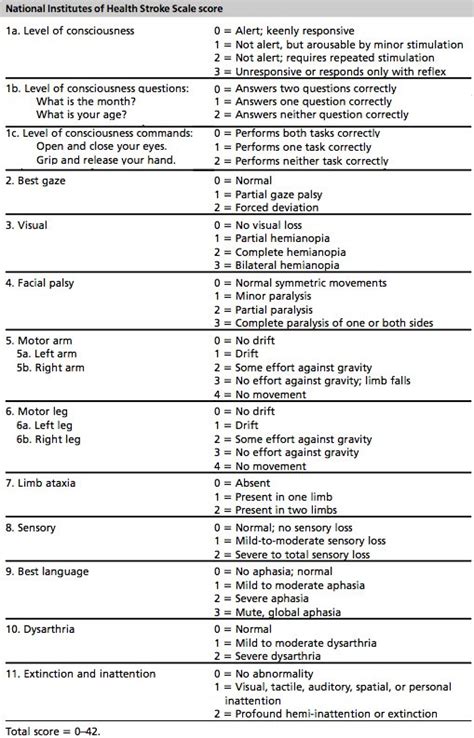
Understanding the Importance of Language Accessibility in Healthcare
In today's diverse healthcare landscape, linguistic accessibility plays a crucial role in ensuring equitable care for all patients. For Spanish-speaking individuals, language barriers can often impede their ability to fully comprehend medical information and participate in decision-making processes regarding their health. This issue is particularly pronounced in the assessment and management of conditions such as stroke, where timely and accurate communication is paramount.
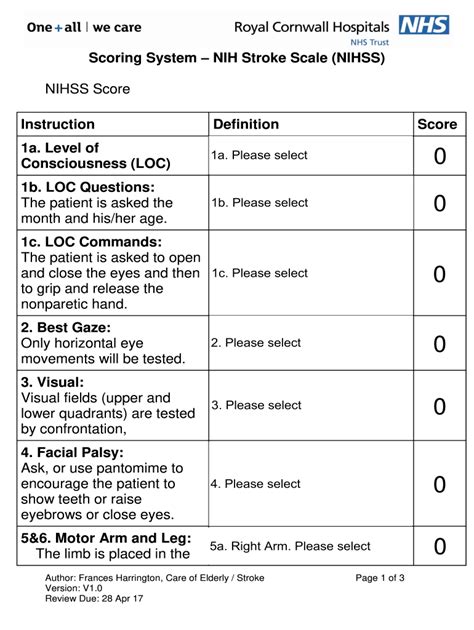
Overview of the NIH Stroke Scale: A Critical Assessment Tool
The NIH Stroke Scale serves as a standardized tool used by healthcare professionals to assess the severity of a stroke and guide treatment decisions. Developed by the National Institutes of Health, this scale evaluates various aspects of neurological function, including consciousness, language, and motor skills. Its widespread adoption has significantly improved the accuracy and consistency of stroke assessments, leading to better patient outcomes.
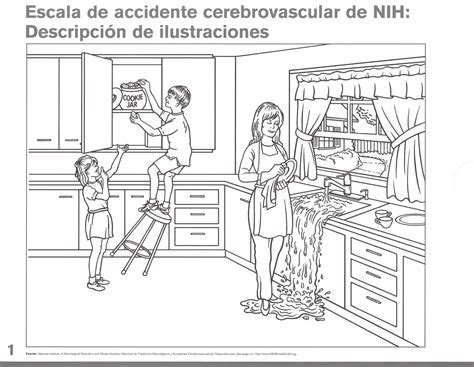
Adapting the NIH Stroke Scale for Spanish-Speaking Patients
To address the needs of Spanish-speaking patients, healthcare providers have developed a Spanish version of the NIH Stroke Scale. This adaptation ensures that individuals who are more comfortable communicating in Spanish can receive the same level of care and assessment as their English-speaking counterparts. By translating the scale into Spanish, healthcare professionals can effectively communicate with a broader range of patients and tailor treatment plans to meet their specific needs.

Benefits of Utilizing the Spanish Version of NIH Stroke Scale
The introduction of the Spanish version of the NIH Stroke Scale brings numerous benefits to both patients and healthcare providers. Firstly, it enhances the accuracy of stroke assessments for Spanish-speaking individuals, ensuring that they receive appropriate treatment in a timely manner. Additionally, it fosters better communication between patients and providers, leading to improved patient satisfaction and outcomes.

Ensuring Accuracy and Consistency in Stroke Assessment Across Language Barriers
One of the primary challenges in stroke care is maintaining consistency in assessment across different linguistic groups. The Spanish version of the NIH Stroke Scale helps address this challenge by providing a standardized tool that can be used uniformly among Spanish-speaking patients. This ensures that assessments are conducted consistently regardless of language, leading to more reliable diagnoses and treatment decisions.
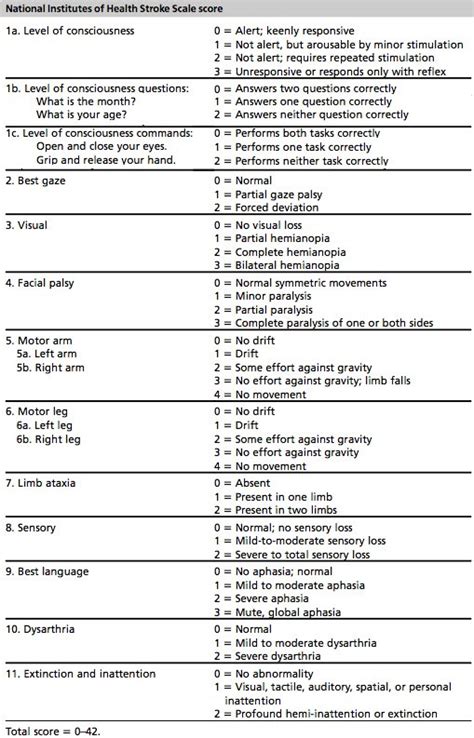
Improving Communication and Collaboration Among Multilingual Healthcare Teams
The availability of the Spanish version of the NIH Stroke Scale not only benefits patients but also enhances communication and collaboration among healthcare teams. Multilingual providers can more effectively communicate with their Spanish-speaking colleagues and collaborate on patient care plans. This leads to smoother coordination of care and better outcomes for patients from diverse linguistic backgrounds.

Addressing Disparities in Stroke Care Through Linguistic Accessibility
Linguistic barriers have long been recognized as a contributing factor to healthcare disparities, particularly in the realm of stroke care. The availability of the Spanish version of the NIH Stroke Scale represents a significant step towards addressing these disparities and ensuring that all patients, regardless of language proficiency, receive equitable care.

Enhancing Patient Understanding and Informed Decision-Making
By providing stroke assessments in Spanish, healthcare providers empower Spanish-speaking patients to fully understand their condition and participate in informed decision-making regarding their treatment options. This not only improves patient satisfaction but also leads to better treatment adherence and outcomes in the long term.

Training and Education: Empowering Providers to Utilize the Spanish NIH Stroke Scale Effectively
Effective utilization of the Spanish version of the NIH Stroke Scale requires training and education for healthcare providers. By offering resources and support for providers to become proficient in administering the scale in Spanish, healthcare organizations can ensure its widespread adoption and maximize its benefits for Spanish-speaking patients.
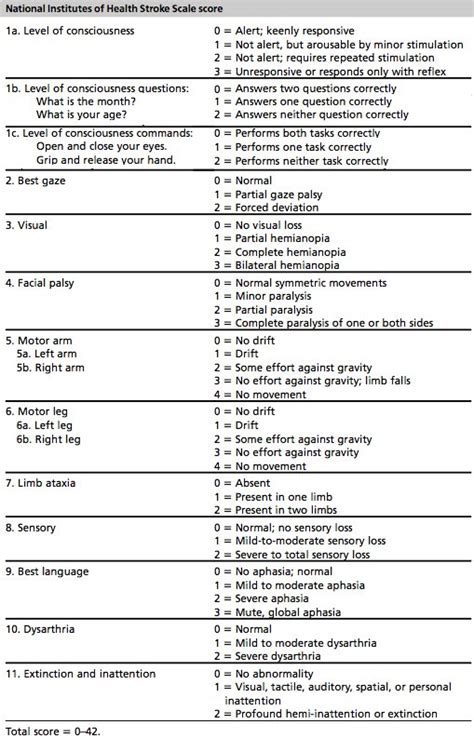
Future Directions: Advancing Stroke Care Through Linguistic Diversity and Inclusion
As healthcare continues to evolve, there is a growing recognition of the importance of linguistic diversity and inclusion in improving patient outcomes. Moving forward, efforts to advance stroke care must prioritize linguistic accessibility and ensure that all patients
Spanish version of NIH Stroke Scale in Professional's eye
In the realm of healthcare, the introduction of the
Spanish version of the NIH Stroke Scale represents a significant advancement in addressing linguistic disparities and enhancing the quality of stroke care for Spanish-speaking populations. This adaptation of the
NIH Stroke Scale aims to ensure that individuals who communicate primarily in Spanish receive the same level of comprehensive assessment and treatment options as their English-speaking counterparts. With stroke being a leading cause of death and disability worldwide, it's imperative that healthcare providers have access to tools that facilitate accurate and timely diagnosis and intervention. The availability of the
Spanish version of the NIH Stroke Scale not only promotes language accessibility but also fosters greater inclusivity in healthcare delivery, aligning with the principles of patient-centered care. By incorporating linguistic diversity into stroke assessment protocols, healthcare professionals can effectively bridge communication gaps and tailor treatment plans to meet the unique needs of Spanish-speaking patients. This not only enhances patient satisfaction but also contributes to improved clinical outcomes and reduced healthcare disparities. Furthermore, the utilization of the
Spanish version of the NIH Stroke Scale underscores the importance of cultural competence in healthcare delivery, as it acknowledges and respects the linguistic and cultural diversity within patient populations. As healthcare systems strive to promote equity and inclusivity, initiatives like the
Spanish version of the NIH Stroke Scale serve as tangible steps towards achieving these goals. Through ongoing research, education, and advocacy, healthcare providers can continue to advance linguistic diversity and cultural competency in stroke care, ultimately improving outcomes for all patients, regardless of language or background.
Point of Views : Spanish version of NIH Stroke Scale
The introduction of the
Spanish version of the NIH Stroke Scale addresses a crucial need for linguistic accessibility in healthcare, particularly in the assessment and management of stroke patients.This adaptation ensures that Spanish-speaking individuals have equal access to comprehensive stroke assessments and treatment options, aligning with principles of equity and inclusivity in healthcare delivery.By incorporating linguistic diversity into stroke care protocols, healthcare providers can effectively communicate with Spanish-speaking patients and tailor treatment plans to meet their specific needs.The availability of the
Spanish version of the NIH Stroke Scale promotes cultural competence in healthcare delivery by acknowledging and respecting the linguistic and cultural diversity within patient populations.Utilizing this adapted scale enhances patient satisfaction and improves clinical outcomes by facilitating accurate diagnosis and timely intervention for Spanish-speaking individuals experiencing strokes.Ongoing research, education, and advocacy efforts are essential in advancing linguistic diversity and cultural competency in stroke care, ultimately leading to improved outcomes for all patients, regardless of language or background.
Conclusion :In closing, it's evident that the Spanish version of the NIH Stroke Scale represents a significant stride towards promoting linguistic accessibility and cultural competency in stroke care. By addressing the language barriers faced by Spanish-speaking patients, healthcare providers can ensure that individuals receive comprehensive and equitable assessment and treatment options. The availability of this adapted scale not only enhances communication between patients and providers but also fosters greater inclusivity in healthcare delivery. Moving forward, it's imperative that healthcare systems continue to prioritize initiatives that promote linguistic diversity and cultural competency, ultimately leading to improved outcomes for all patients.As we conclude our exploration of the Spanish version of the NIH Stroke Scale, it's essential to underscore the importance of ongoing research, education, and advocacy in this field. By remaining committed to advancing linguistic diversity and cultural competency in stroke care, we can further enhance patient outcomes and reduce healthcare disparities. I encourage readers to stay informed and engaged in discussions surrounding healthcare accessibility and inclusivity, as we collectively work towards a more inclusive and equitable healthcare system for all individuals, regardless of language or background.
Questions and Answer for Spanish version of NIH Stroke Scale
When exploring the topic of the Spanish version of the NIH Stroke Scale, several common questions arise:
- 1. What is the purpose of the Spanish version of the NIH Stroke Scale?
The purpose of the Spanish version of the NIH Stroke Scale is to provide a standardized tool for assessing the severity of strokes in Spanish-speaking individuals. It ensures that patients who communicate primarily in Spanish receive the same level of comprehensive assessment and treatment options as their English-speaking counterparts.
- 2. How does the Spanish version differ from the original NIH Stroke Scale?
The Spanish version of the NIH Stroke Scale is essentially a translated adaptation of the original scale, designed specifically for Spanish-speaking patients. While the core components and assessment criteria remain the same, the language and terminology used in the scale are tailored to accommodate Spanish-speaking individuals.
- 3. Who benefits from the availability of the Spanish version of the NIH Stroke Scale?
The availability of the Spanish version of the NIH Stroke Scale benefits both patients and healthcare providers. Patients who communicate primarily in Spanish can better understand their condition and participate in treatment decisions, leading to improved outcomes. Healthcare providers can effectively communicate with Spanish-speaking patients and deliver more tailored care plans.
- 4. How can healthcare professionals access and utilize the Spanish version of the NIH Stroke Scale?
Healthcare professionals can typically access the Spanish version of the NIH Stroke Scale through healthcare institutions, medical organizations, or online resources. Utilizing the scale involves administering it to Spanish-speaking patients as part of the stroke assessment process and interpreting the results to guide treatment decisions effectively.
By addressing these common questions, individuals can gain a better understanding of the purpose, benefits, and utilization of the Spanish version of the NIH Stroke Scale in healthcare settings.
Label :Spanish Version, NIH Stroke Scale, Healthcare Accessibility, Linguistic Diversity
Keyword : Spanish version of NIH Stroke Scale

Discover the significance of the Spanish version of NIH Stroke Scale. Enhance stroke assessment and treatment for Spanish-speaking patients and healthcare providers.
In the realm of healthcare, the Spanish version of the NIH Stroke Scale stands as a pivotal tool in the assessment and management of stroke patients. Its significance lies not only in its ability to accurately gauge the severity of a stroke but also in its capacity to guide treatment decisions swiftly and effectively. As healthcare professionals strive for equitable and inclusive care, the availability of NIH Stroke Scale in Spanish addresses a crucial need for accessibility and comprehension among Spanish-speaking patients and providers alike. In this article, we delve into the intricacies of this vital instrument, exploring its relevance, application, and impact within the healthcare landscape. Join us as we navigate through the nuances of stroke care, transcending language barriers to ensure optimal outcomes for all.
Top 10 Points about Spanish version of NIH Stroke Scale :
- Understanding the Importance of Language Accessibility in Healthcare
- Overview of the NIH Stroke Scale: A Critical Assessment Tool
- Adapting the NIH Stroke Scale for Spanish-Speaking Patients
- Benefits of Utilizing the Spanish Version of NIH Stroke Scale
- Ensuring Accuracy and Consistency in Stroke Assessment Across Language Barriers
- Improving Communication and Collaboration Among Multilingual Healthcare Teams
- Addressing Disparities in Stroke Care Through Linguistic Accessibility
- Enhancing Patient Understanding and Informed Decision-Making
- Training and Education: Empowering Providers to Utilize the Spanish NIH Stroke Scale Effectively
- Future Directions: Advancing Stroke Care Through Linguistic Diversity and Inclusion
Several facts about Spanish version of NIH Stroke Scale

Understanding the Importance of Language Accessibility in Healthcare
In today's diverse healthcare landscape, linguistic accessibility plays a crucial role in ensuring equitable care for all patients. For Spanish-speaking individuals, language barriers can often impede their ability to fully comprehend medical information and participate in decision-making processes regarding their health. This issue is particularly pronounced in the assessment and management of conditions such as stroke, where timely and accurate communication is paramount.

Overview of the NIH Stroke Scale: A Critical Assessment Tool
The NIH Stroke Scale serves as a standardized tool used by healthcare professionals to assess the severity of a stroke and guide treatment decisions. Developed by the National Institutes of Health, this scale evaluates various aspects of neurological function, including consciousness, language, and motor skills. Its widespread adoption has significantly improved the accuracy and consistency of stroke assessments, leading to better patient outcomes.

Adapting the NIH Stroke Scale for Spanish-Speaking Patients
To address the needs of Spanish-speaking patients, healthcare providers have developed a Spanish version of the NIH Stroke Scale. This adaptation ensures that individuals who are more comfortable communicating in Spanish can receive the same level of care and assessment as their English-speaking counterparts. By translating the scale into Spanish, healthcare professionals can effectively communicate with a broader range of patients and tailor treatment plans to meet their specific needs.

Benefits of Utilizing the Spanish Version of NIH Stroke Scale
The introduction of the Spanish version of the NIH Stroke Scale brings numerous benefits to both patients and healthcare providers. Firstly, it enhances the accuracy of stroke assessments for Spanish-speaking individuals, ensuring that they receive appropriate treatment in a timely manner. Additionally, it fosters better communication between patients and providers, leading to improved patient satisfaction and outcomes.

Ensuring Accuracy and Consistency in Stroke Assessment Across Language Barriers
One of the primary challenges in stroke care is maintaining consistency in assessment across different linguistic groups. The Spanish version of the NIH Stroke Scale helps address this challenge by providing a standardized tool that can be used uniformly among Spanish-speaking patients. This ensures that assessments are conducted consistently regardless of language, leading to more reliable diagnoses and treatment decisions.

Improving Communication and Collaboration Among Multilingual Healthcare Teams
The availability of the Spanish version of the NIH Stroke Scale not only benefits patients but also enhances communication and collaboration among healthcare teams. Multilingual providers can more effectively communicate with their Spanish-speaking colleagues and collaborate on patient care plans. This leads to smoother coordination of care and better outcomes for patients from diverse linguistic backgrounds.

Addressing Disparities in Stroke Care Through Linguistic Accessibility
Linguistic barriers have long been recognized as a contributing factor to healthcare disparities, particularly in the realm of stroke care. The availability of the Spanish version of the NIH Stroke Scale represents a significant step towards addressing these disparities and ensuring that all patients, regardless of language proficiency, receive equitable care.

Enhancing Patient Understanding and Informed Decision-Making
By providing stroke assessments in Spanish, healthcare providers empower Spanish-speaking patients to fully understand their condition and participate in informed decision-making regarding their treatment options. This not only improves patient satisfaction but also leads to better treatment adherence and outcomes in the long term.

Training and Education: Empowering Providers to Utilize the Spanish NIH Stroke Scale Effectively
Effective utilization of the Spanish version of the NIH Stroke Scale requires training and education for healthcare providers. By offering resources and support for providers to become proficient in administering the scale in Spanish, healthcare organizations can ensure its widespread adoption and maximize its benefits for Spanish-speaking patients.

Future Directions: Advancing Stroke Care Through Linguistic Diversity and Inclusion
As healthcare continues to evolve, there is a growing recognition of the importance of linguistic diversity and inclusion in improving patient outcomes. Moving forward, efforts to advance stroke care must prioritize linguistic accessibility and ensure that all patients
Spanish version of NIH Stroke Scale in Professional's eye
In the realm of healthcare, the introduction of the
Spanish version of the NIH Stroke Scale represents a significant advancement in addressing linguistic disparities and enhancing the quality of stroke care for Spanish-speaking populations. This adaptation of the
NIH Stroke Scale aims to ensure that individuals who communicate primarily in Spanish receive the same level of comprehensive assessment and treatment options as their English-speaking counterparts. With stroke being a leading cause of death and disability worldwide, it's imperative that healthcare providers have access to tools that facilitate accurate and timely diagnosis and intervention. The availability of the
Spanish version of the NIH Stroke Scale not only promotes language accessibility but also fosters greater inclusivity in healthcare delivery, aligning with the principles of patient-centered care. By incorporating linguistic diversity into stroke assessment protocols, healthcare professionals can effectively bridge communication gaps and tailor treatment plans to meet the unique needs of Spanish-speaking patients. This not only enhances patient satisfaction but also contributes to improved clinical outcomes and reduced healthcare disparities. Furthermore, the utilization of the
Spanish version of the NIH Stroke Scale underscores the importance of cultural competence in healthcare delivery, as it acknowledges and respects the linguistic and cultural diversity within patient populations. As healthcare systems strive to promote equity and inclusivity, initiatives like the
Spanish version of the NIH Stroke Scale serve as tangible steps towards achieving these goals. Through ongoing research, education, and advocacy, healthcare providers can continue to advance linguistic diversity and cultural competency in stroke care, ultimately improving outcomes for all patients, regardless of language or background.
Point of Views : Spanish version of NIH Stroke Scale
The introduction of the
Spanish version of the NIH Stroke Scale addresses a crucial need for linguistic accessibility in healthcare, particularly in the assessment and management of stroke patients.This adaptation ensures that Spanish-speaking individuals have equal access to comprehensive stroke assessments and treatment options, aligning with principles of equity and inclusivity in healthcare delivery.By incorporating linguistic diversity into stroke care protocols, healthcare providers can effectively communicate with Spanish-speaking patients and tailor treatment plans to meet their specific needs.The availability of the
Spanish version of the NIH Stroke Scale promotes cultural competence in healthcare delivery by acknowledging and respecting the linguistic and cultural diversity within patient populations.Utilizing this adapted scale enhances patient satisfaction and improves clinical outcomes by facilitating accurate diagnosis and timely intervention for Spanish-speaking individuals experiencing strokes.Ongoing research, education, and advocacy efforts are essential in advancing linguistic diversity and cultural competency in stroke care, ultimately leading to improved outcomes for all patients, regardless of language or background.
Conclusion :In closing, it's evident that the Spanish version of the NIH Stroke Scale represents a significant stride towards promoting linguistic accessibility and cultural competency in stroke care. By addressing the language barriers faced by Spanish-speaking patients, healthcare providers can ensure that individuals receive comprehensive and equitable assessment and treatment options. The availability of this adapted scale not only enhances communication between patients and providers but also fosters greater inclusivity in healthcare delivery. Moving forward, it's imperative that healthcare systems continue to prioritize initiatives that promote linguistic diversity and cultural competency, ultimately leading to improved outcomes for all patients.As we conclude our exploration of the Spanish version of the NIH Stroke Scale, it's essential to underscore the importance of ongoing research, education, and advocacy in this field. By remaining committed to advancing linguistic diversity and cultural competency in stroke care, we can further enhance patient outcomes and reduce healthcare disparities. I encourage readers to stay informed and engaged in discussions surrounding healthcare accessibility and inclusivity, as we collectively work towards a more inclusive and equitable healthcare system for all individuals, regardless of language or background.
Questions and Answer for Spanish version of NIH Stroke Scale
When exploring the topic of the Spanish version of the NIH Stroke Scale, several common questions arise:
- 1. What is the purpose of the Spanish version of the NIH Stroke Scale?
The purpose of the Spanish version of the NIH Stroke Scale is to provide a standardized tool for assessing the severity of strokes in Spanish-speaking individuals. It ensures that patients who communicate primarily in Spanish receive the same level of comprehensive assessment and treatment options as their English-speaking counterparts.
- 2. How does the Spanish version differ from the original NIH Stroke Scale?
The Spanish version of the NIH Stroke Scale is essentially a translated adaptation of the original scale, designed specifically for Spanish-speaking patients. While the core components and assessment criteria remain the same, the language and terminology used in the scale are tailored to accommodate Spanish-speaking individuals.
- 3. Who benefits from the availability of the Spanish version of the NIH Stroke Scale?
The availability of the Spanish version of the NIH Stroke Scale benefits both patients and healthcare providers. Patients who communicate primarily in Spanish can better understand their condition and participate in treatment decisions, leading to improved outcomes. Healthcare providers can effectively communicate with Spanish-speaking patients and deliver more tailored care plans.
- 4. How can healthcare professionals access and utilize the Spanish version of the NIH Stroke Scale?
Healthcare professionals can typically access the Spanish version of the NIH Stroke Scale through healthcare institutions, medical organizations, or online resources. Utilizing the scale involves administering it to Spanish-speaking patients as part of the stroke assessment process and interpreting the results to guide treatment decisions effectively.
By addressing these common questions, individuals can gain a better understanding of the purpose, benefits, and utilization of the Spanish version of the NIH Stroke Scale in healthcare settings.
Label :Spanish Version, NIH Stroke Scale, Healthcare Accessibility, Linguistic Diversity
Keyword : Spanish version of NIH Stroke Scale
0 komentar